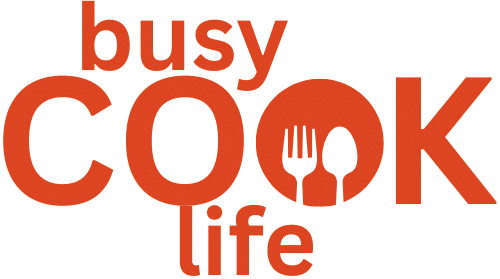Some mornings feel like a dozen small alarms. When the house hums and I need a quick hug in a mug, I reach for my pink salt coffee recipe. One tiny change—one micro pinch—turned bitter cups into a gentler, more pleasant ritual.
I choose Himalayan pink salt for this because it’s less processed than some table salts and contains trace minerals (potassium and magnesium among them). Those minerals are present only in very small amounts, so they won’t replace a balanced diet, but a whisper of this salt can soften bitterness and round the cup’s flavor without making it taste salty. The result: bold coffee with less edge and a steadier morning feel—an anecdotal energy lift I notice on busy days.
It’s simple: fresh coffee, a tiny sprinkle of himalayan pink salt, and a splash of cream if you want richness. Scroll to the recipe section below for exact steps and troubleshooting. Try one micro pinch, taste, then adjust—small changes are all you need.
Key Takeaways
- A tiny pinch in your pink salt coffee can smooth bitterness and balance taste.
- Himalayan pink salt is less refined and carries trace minerals, used here for subtle effect rather than nutrition.
- This method keeps mornings simple—hot cup, small tweak, steady energy.
- Moderation matters for health—watch sodium if you need to.
- Works with your favorite beans and simple add-ins—no fancy tools required.
The morning I fell for pink salt coffee, and why it stuck
One groggy morning after a night of laundry, a single tiny pinch changed how I felt about my cup. At the first sip I paused—same beans, new balance—and suddenly I actually liked my mug again.
I admit, salt coffee sounded odd at first. I’d seen versions on high-end menus and the salted‑foam trend at cafes like 85°C, so I tried a whisper of himalayan pink salt and kept it very small—just a few grains between my fingers.
The result: the drink smoothed out, the bitter edge softened, and I skipped extra cream and sugar and still smiled. I tested light, bright roasts and darker beans; the technique felt most noticeable on brighter, higher‑acidity brews but worked across methods when used sparingly.
- It stuck because it’s easy—one second in a packed morning.
- Friends raised eyebrows at “salt coffee,” then tried it and texted back surprised, happy reactions.
- If you’re skeptical, start with a few grains—taste, then add only if needed.
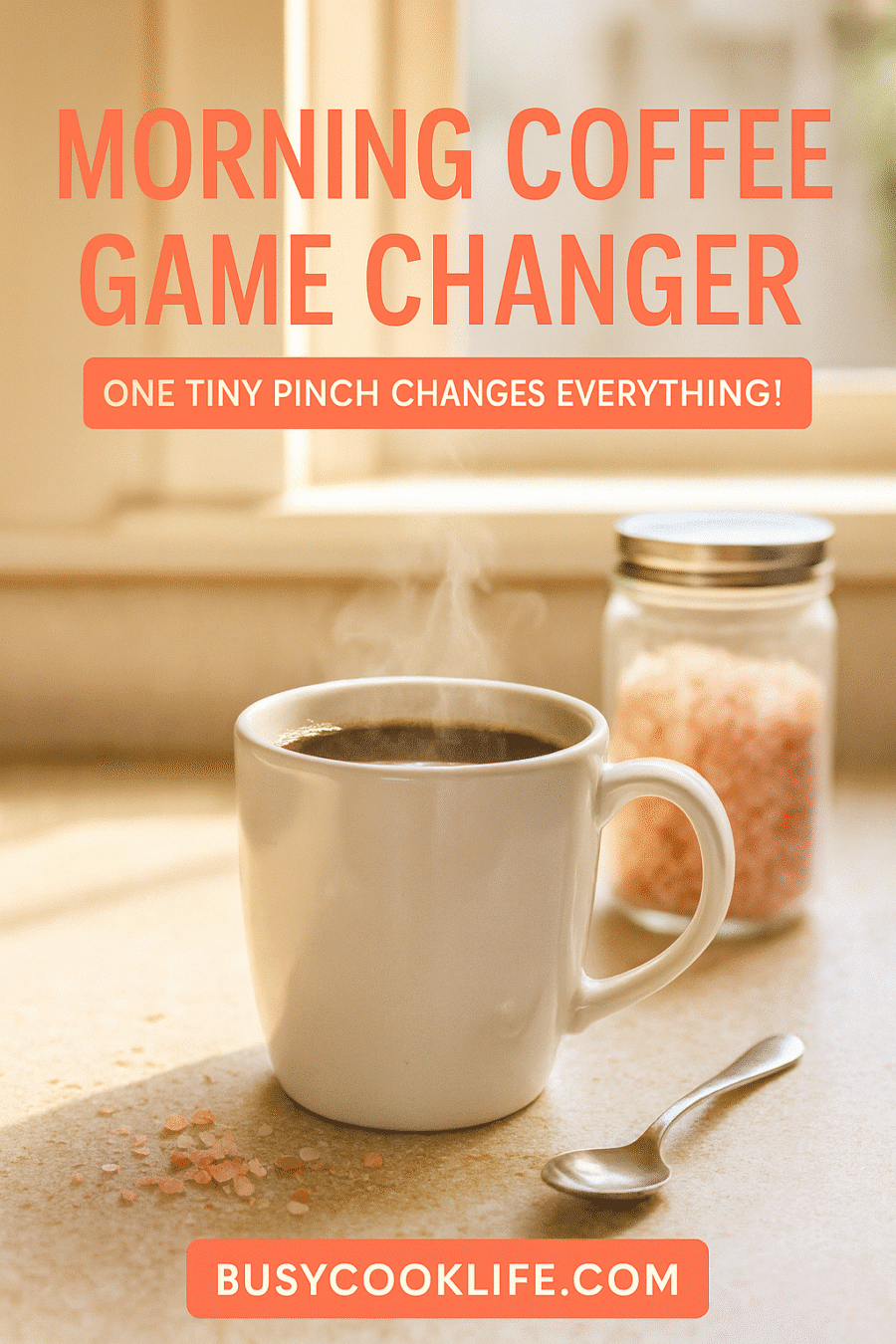
Now, when I want a reliable cup, I reach for that same micro pinch. It keeps roast character intact while removing harshness. For a quick read on the idea behind the tweak, see this salt in coffee guide. See the recipe section below for exact steps if you want to try it yourself.
What makes Himalayan pink salt special in coffee
A single, careful pinch of ancient Himalayan crystals softens acidity without masking bean character. I first noticed this with a bright roast: a whisper of salt softened the sharp edges and made the cup more pleasant. It’s a tiny habit that keeps my mug balanced without stealing the coffee’s personality.
Trace minerals 101: potassium, magnesium, and calcium
Himalayan pink salt is harvested from ancient rock salt deposits (commonly associated with Pakistan’s salt mines). Its soft blush comes from trace minerals—potassium, magnesium, and calcium—that appear in very small amounts. Those minerals are present only in trace quantities (not a dietary substitute), but they can subtly nudge mouthfeel and perceived acidity.
They won’t replace a balanced diet, but a micro pinch can make the brew feel less bitter and, for some people, easier on digestion.
Less processed than table salt: what that means for flavor
Because himalayan pink is typically less refined than some table salts, it retains tiny mineral traces that can influence flavor. The grains dissolve predictably in hot liquid, so one careful pinch—think a few grains between your fingers—does the job without making the cup salty.
- Origin: ancient deposits in Pakistan’s salt regions.
- Effect on taste: tucks bitterness away and rounds the flavor.
- Practical benefit: a small sensory nudge toward hydration feel and gentler mouthfeel (trace amounts only).
| FeatureWhat it doesWhy I care | ||
| Trace minerals | Potassium, magnesium, calcium in tiny amounts | Softens bite; mild sensory effect (not a nutrition source) |
| Processing | Less refined than table salt | Retains subtle minerals that affect flavor |
| In the mug | Reduces perceived bitterness and acidity | Smoother finish; easier on digestion for some people |
| Health note | Small amounts matter; watch sodium | Moderation keeps benefits without risks |
Pink salt coffee recipe
I can make a gentler, bolder cup in under a minute with one small adjustment. Here’s the quick method I use when I’m racing the school run or need a dependable pick‑me‑up.
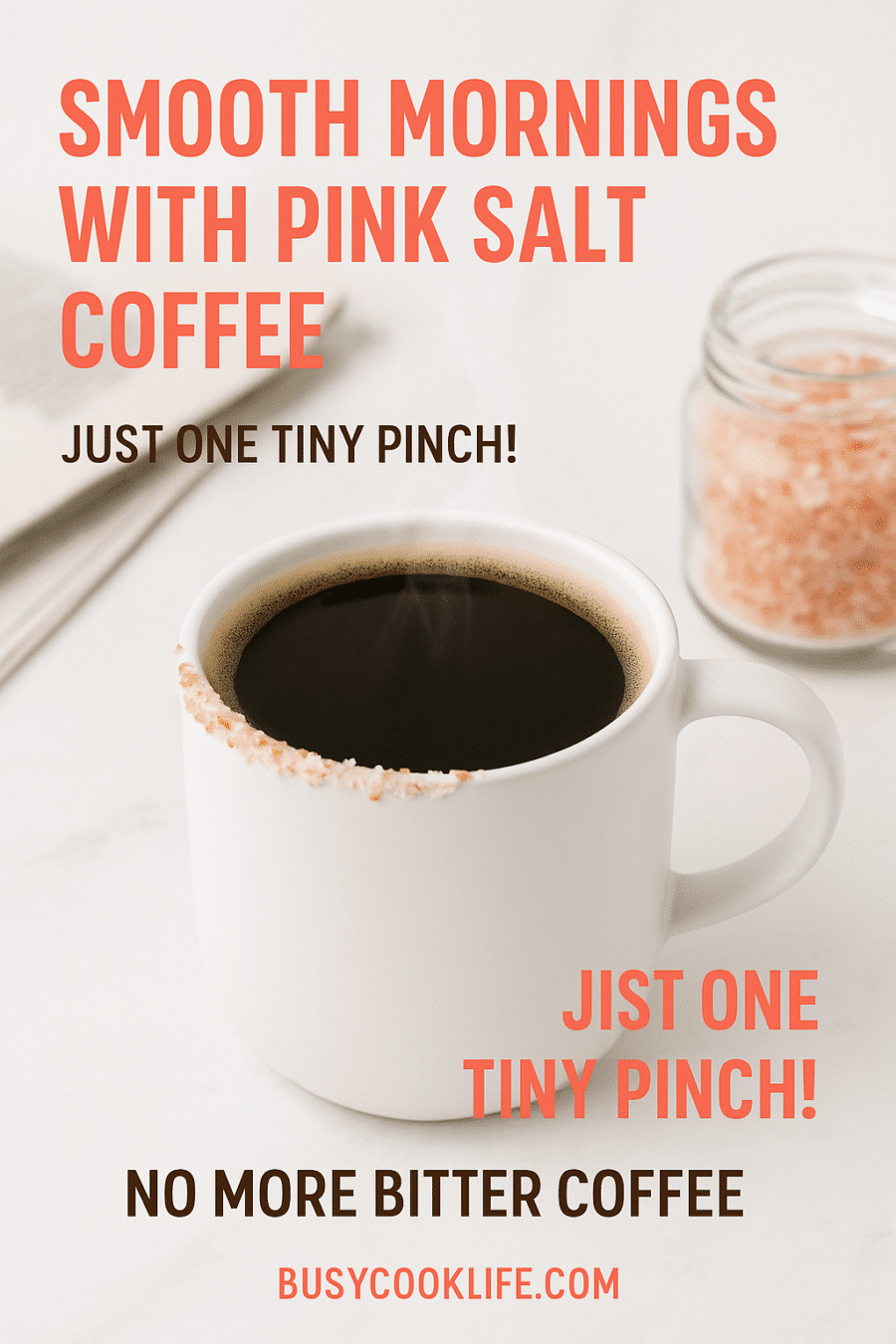
Ingredients you already have
Coffee, a tiny fingertip pinch of himalayan pink, and optional milk or cream. That’s it—no fancy tools.
Step-by-step: creamy, balanced, and not salty
- Set a mug by the brewer and brew strong (8–10 oz is a good target). Pour hot into the cup so any grains dissolve quickly.
- For one cup, add a micro pinch—literally a few grains between your fingers (fingertip pinch ≈ a few grains; do not exceed 1/16 tsp). Stir to dissolve and taste.
- If you want more body, add a splash of milk or a dash of cream. Start light—too much will change the balance.
- For a latte vibe, warm and froth milk ~20 seconds, pour over the brewed coffee, and finish with one tiny extra pinch on top if desired.
- For iced versions, dissolve the pinch in a small amount of hot brew first, then pour over ice and add cream or milk.
| StepTimingQuick tip | ||
| Brew strong | 0:00–0:30 | Use fresh beans for best flavor coffee |
| Add pinch | Right after pour | Start tiny—you can always add pinch |
| Stir & taste | 0:30–0:45 | Decide on milk or cream after tasting |
| Iced option | 1:00 | Dissolve in hot, then chill over ice |
I’ve tested drip, French press, and AeroPress—each accepts the micro pinch when you add it after pouring. Keep the pinch himalayan pink tiny and taste as you go. If the cup tastes salty, dilute with more brew or milk and note a smaller pinch next time. Try and record results (pinch size + roast) so you can repeat the cup you like.
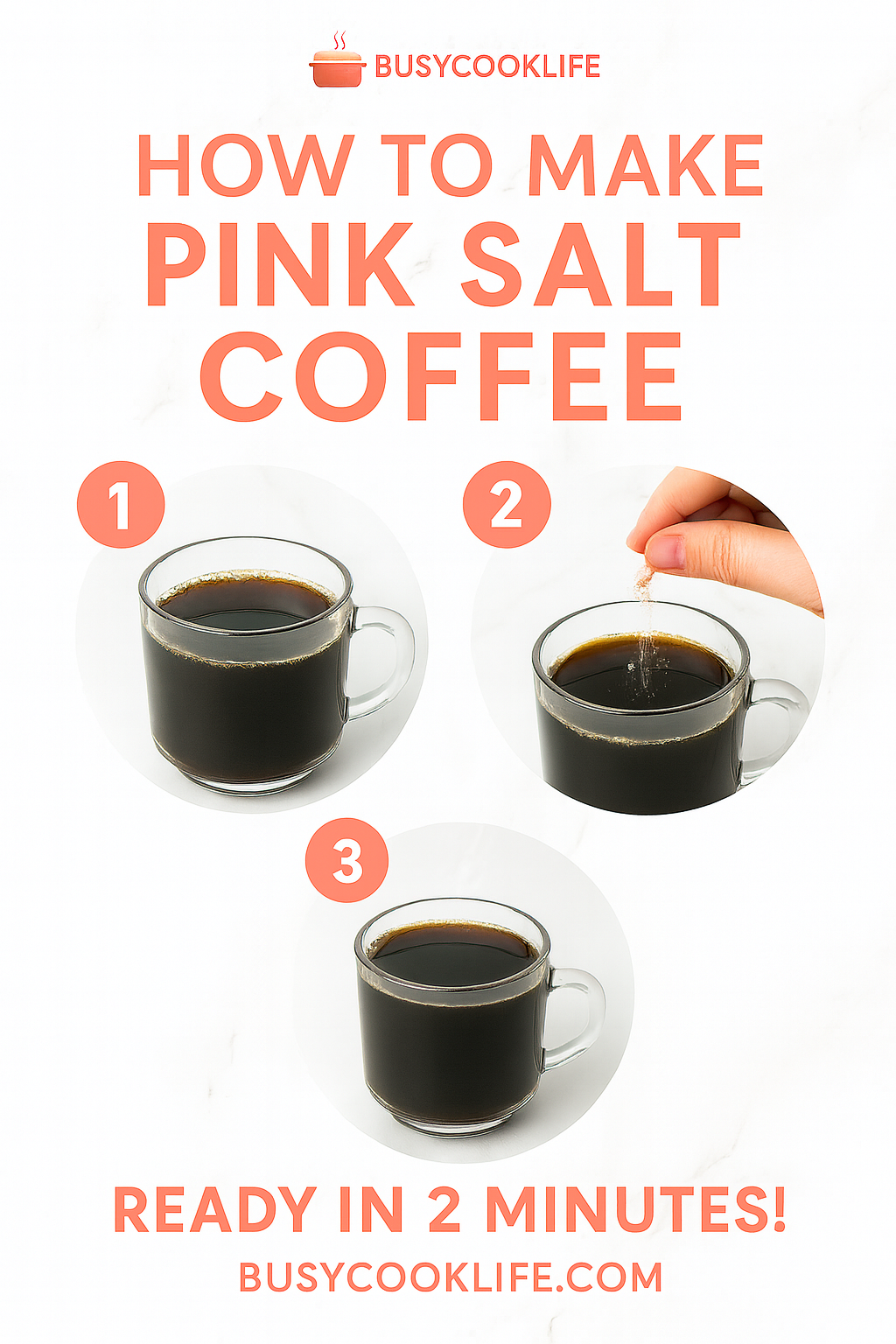
How a pinch of salt transforms flavor, taste, and acidity
A tiny change makes a big difference. I add a micro pinch to calm harsh edges. The result is a cup that feels more balanced and kinder on the tongue.
Cutting bitterness without sugar
Salt can blunt some bitterness receptors (a sensory effect noted in taste research), so the flavor shifts from sharp to rounded without adding sweetness. I often notice chocolate and caramel notes come forward—especially in medium and darker roasts—so there’s less need for extra cream or sugar, and the finish stays cleaner.
Reducing acidity for a gentler sip
A controlled pinch tames perceived acidity. When a bright brew bites, a whisper of mineral softens the after‑sip. Cold brew typically reads less acidic to begin with, so it needs the tweak less often, but a tiny pinch can still nudge balance if you want a touch more roundness.
“Adding salt to coffee isn’t about making it salty — it’s about nudging balance so the cup reads kinder on the tongue.”
- Salt blunts bitterness receptors and lets other flavor notes open up.
- Use a micro pinch — you can always add more, you can’t take it back.
- I prefer himalayan pink salt because it dissolves cleanly and respects roast character.
| IssueWhat to doQuick tip | ||
| Too bitter | Add a tiny pinch right after pour | Stir, taste, then stop |
| Too acidic | Micro pinch to soften sharp notes | Try a darker roast next time |
| Too strong | Pinch + splash of milk | Dilute the brew rather than double the pinch |
Energy boost, hydration, and digestion — the real-life benefits
That tiny tweak in my mug does more than smooth flavor—it can slightly change how my body greets the morning. These effects are anecdotal for me, but they show up most when every minute counts.
Electrolyte support from that tiny pinch
A micro pinch adds trace minerals like potassium and magnesium. Those minerals are present only in very small amounts, so this isn’t a substitute for proper hydration or sports drinks after intense exercise—but the sip can feel a bit more quenching if you pair it with water after physical activity.
In practice, the drink can feel mildly more refreshing; I often follow my coffee with water after a workout and the combination works well for short bursts of activity.
Why it feels easier on my stomach than plain coffee
For me, the cup lands softer. A whisper of mineral seems to lower perceived acidity a touch, and that gentler finish can ease the usual mid‑morning stomach grumble for some people.
When I skip the crash: steadier morning energy
I notice clearer, steadier energy on busy mornings—less temptation for an immediate sweet snack. That’s subjective, not clinical, but the tweak often helps me avoid extra sweeteners that would spike blood sugar.
- Quenching sip: trace minerals may make the drink feel slightly more hydrating when paired with water.
- Gentler gut: reduced perceived acidity can be easier on digestion for some people.
- Stable drive: dialing back cream and sugar after using a micro pinch can help steady appetite and energy.
Medical note: if you have hypertension or a sodium‑sensitive condition, check with your healthcare provider before adding salt regularly (see Troubleshooting). These observations are anecdotal; they describe how the tweak feels for me and others, not a medical claim.
If you want a quick deep-dive on reported benefits, see this guide to adding a pinch to your brew: pink salt coffee.
Choose your salt wisely: Himalayan pink, Peruvian Pink, or Trapani
Choosing the right grain can quietly change how your morning cup greets you. Chefs use salted coffee to tame bitterness and lift sweetness; at home, a tiny mineral choice can do the same. If you’re new to this, start with Himalayan pink—it’s forgiving and easy to work with.
What I reach for, and when
Himalayan pink salt is my go-to for everyday mugs. It dissolves fast and blends in, so the taste reads round without stealing the show.
When I want a crisp, clean finish I reach for Trapani sea salt—great for lighter roasts where clarity matters.
Peruvian Pink brings a soft mineral note that pairs well with delicate beans, nudging balance without masking aroma.
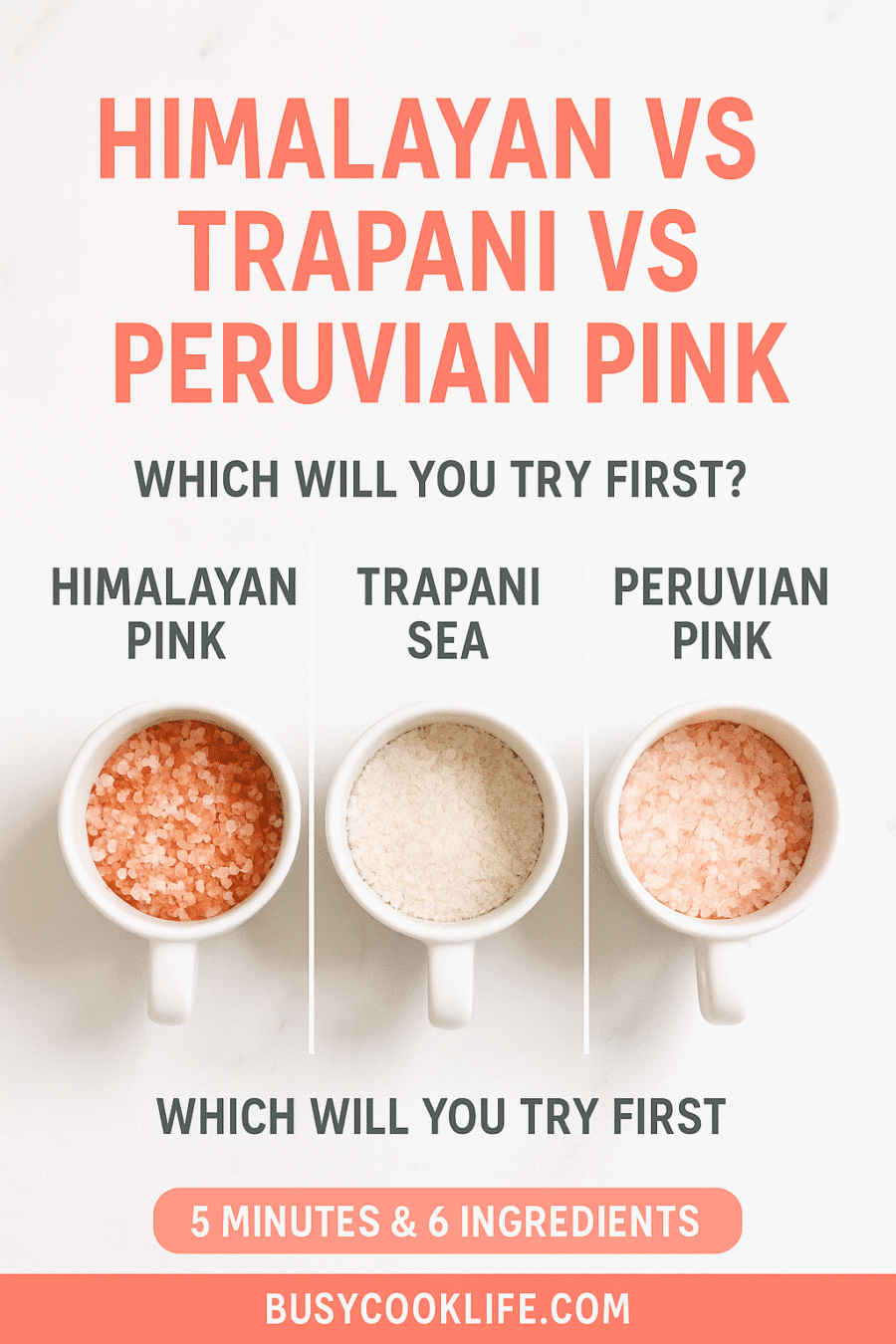
- Start tiny—a micro pinch. Salted coffee works best when subtle.
- For cold brews, dissolve the pinch in a small amount of warm brew first, then chill to avoid uneven distribution.
- If you’re introducing a friend, begin with Himalayan pink and move to Trapani or Peruvian after a few wins.
- People watching sodium should keep amounts minimal—small benefits, small risk.
| SaltBest forEffect | ||
| Himalayan pink salt | Everyday cups | Fast dissolve; rounds bitterness |
| Trapani sea salt | Clean finish | Brightens flavor; crisp aftertaste |
| Peruvian Pink | Light roasts | Gentle mineral balance |
Make it yours: milk, cream, or dairy-free twists
Warm milk softens the mug and lets tiny minerals sit in the background. I prefer simple swaps that change texture more than taste. A small tweak—milk, cream, or plant milk—can make the morning cup feel personal and steady.
Silky latte vibes with cream or milk
For latte vibes, warm milk, add a micro pinch of pinch himalayan pink, then pour it into the coffee for a silky cup that still honors roast character. Heavy cream makes a luxe mug; just a splash keeps the brew front and center.
Quick tip: half‑and‑half mixes fast and works great on busy mornings. Remember: dairy amplifies flavors, so keep the pinch tiny—start with a few grains.
Oat, coconut, or almond for a lighter cup
If dairy isn’t your thing, oat, coconut, or almond milk add different textures. Oat + pinch = the creamiest mouthfeel; coconut adds gentle sweetness without sugar; almond keeps the cup light and toasty.
- Keep the salt tiny because milk and cream amplify flavor—fewer grains with richer milks.
- For quick foam, shake warm milk in a jar for ~20 seconds.
- Add a drop of vanilla if the cup needs more depth.
- Try iced coffee with coconut milk and a subtle pinch for porch‑worthy sips.
Make it yours: taste, then tweak. Try the oat + pinch combo today and note the pinch size so you can repeat it on busy mornings. If you want a quick mug treat to go with this, try my mug cake.
Sweet or not: sugar, honey, or “just coffee”
When my mug tastes balanced, I rarely reach for sugar. A tiny mineral tweak often calms bitterness and keeps the bean notes clear, so you can enjoy a cleaner finish with less sweetener.
Balancing sweetness without losing that clean flavor
I add a micro pinch first—just a few grains—and taste. If I still want sweetness, I drizzle a small amount of honey and test again. A little goes a long way.
- The pinch cuts bitterness, so you can often skip sugar and let the beans speak; the cup stays clear and bright.
- If you want sweetness, add a small drizzle of honey and taste before more.
- When tempted by syrup, try salt instead first; the pinch often calms the edge and preserves real bean flavor.
- People who always add sugar might simply need a smoother baseline—start with a few grains (a fingertip pinch) and adjust.
For iced drinks, sweetness reads louder—try half your usual sugar plus the pinch and see if that fills the gap. Keep a quick note (roast + pinch size + sweetener) so you can recreate the perfect cup on busy mornings.
| GoalActionQuick tip | ||
| Less bitter | Add a micro pinch (use pink salt) | Stir, then taste |
| Sweet treat | Drizzle honey | Start small |
| Iced | Half sugar + pinch | Sweetness reads louder cold |
Troubleshooting and side effects to watch for
If your mug turns briny, don’t panic—there are easy fixes and safer ways to proceed. This is short and practical so you can sip happy and stay safe.
Too salty? Fix the pinch
If it tastes salty, you used too much. Add fresh hot brew or a splash of milk to dilute, stir, then taste. Note a smaller pinch next time and avoid adding salt twice—you can always add, you can’t take it out.
Start tiny—measure “a few grains” between your fingers (a fingertip pinch is a few grains; do not exceed ~1/16 tsp). If bitterness persists, check grind size, brew time, or use fresher beans before reaching for more salt.
Sensitive to sodium or high blood pressure? Read this first
If you have high blood pressure or follow a sodium‑restricted plan, talk to your healthcare provider before adding salt regularly. People with heart or blood concerns should log drinks and symptoms to spot patterns and stop if advised.
How much salt is too much in coffee
Keep the pinch micro. Too much can overpower flavor and contribute to excess sodium intake. If you notice unusual thirst, headache, or bloating after adding salt, stop, dilute the cup, and hydrate.
- If mug tastes salty: dilute with more brew or milk and use a smaller pinch next time.
- Start tiny and avoid adding twice—small steps win.
- People with high blood pressure should consult a pro before adding salt regularly.
- Log what you drink and any effects on your blood pressure or mood.
- Use food‑grade Himalayan only; decorative crystals aren’t for drinking.
For a quick expert perspective on this tweak, see what experts say.
Quick variations for different moods and diets
A few simple tweaks turn my usual mug into whatever mood I need—calm, creamy, or cool. These ideas are fast and repeatable so you can mix them between errands or before work.
Cinnamon, cocoa, or vanilla for cozy mornings
For cozy vibes, stir in a pinch of cinnamon or a dusting of cocoa and add a micro pinch of pinch himalayan pink to round bitterness. Try: medium roast + 1–2 grains + a dash of cinnamon for a bakery‑style cup without extra sugar.
Iced salted coffee with creamy foam for hot days
On warm afternoons, make quick foam by shaking cold milk in a jar. Spoon it over chilled brew and finish with a fine grains‑of‑salt sprinkle—think the sweet‑salt foam trend. Dissolve the pinch in warm brew first for even distribution.
Low-sugar and blood sugar–friendly tweaks
If you’re watching blood sugar or keeping a low‑sugar diet, lean on spice and texture: cinnamon, vanilla, or creamy coconut. Unsweetened almond milk plus a micro pinch makes a light cup that still feels special and helps you skip added sweeteners.
- Cozy: medium roast + cinnamon + tiny pinch for warmth.
- Bakery aroma: a drop of vanilla — little or no sugar needed.
- Iced treat: dissolve pinch warm → chill + foamed milk on top.
- Low‑sugar: use unsweetened plant milks and spices to preserve flavor.
| MoodQuick buildTip | ||
| Cozy | Cinnamon + tiny himalayan pink | Stir, taste, add milk if needed |
| Hot day | Iced brew + foamed milk + sprinkle | Dissolve pinch while warm first |
| Low‑sugar | Spice + almond or coconut milk | Use unsweetened milk; skip syrup |
Pro tip: keep a small flavor shelf by the machine (spices, a small salt jar, and a tiny scoop) so variations happen fast—even on the busiest mornings.
What I sip it with: easy breakfast sides and mug treats
A simple side can make a single sip feel like a slow breath—no extra fuss. I keep pairings small and fast so mornings stay calm. A cozy bite beside the mug turns a rush into a little celebration.
This one’s saved my week more than once
Pair your cup with the 2-minute Cinnamon Roll Mug Cake on BusyCookLife.com for a warm cinnamon hug that plays perfectly with the pinch. It’s quick and comforting—try it with your salted cup for an easy morning treat.
Chocolate craving? Try a brownie mug
For richer mornings, I reach for the 5-Minute Brownie Mug from BusyCookLife.com. It’s dense, fast, and made to match a salted sip.
- I love this cup with a quick treat — a cozy side lifts the whole moment.
- Toast + 1 tbsp peanut butter works when I want protein and speed.
- Yogurt with berries and a splash of milk keeps things light and bright.
- Weekend brunch? Soft scramble plus a dash of cream in the cup feels special.
- People who meal‑prep can freeze muffin batter portions and bake one while coffee brews — instant side.
Health first: I choose sides that fuel steady energy, not stress. Keep it simple, taste as you go, and enjoy five calm minutes before the day starts.
Salted caramel latte ideas also pair nicely when you want a sweeter treat.

Conclusion
A tiny practice at the pour can turn your morning into a calmer, more focused start. I use a micro pinch of himalayan pink salt, and the mug feels smoother without extra sugar.
The main benefits are simple and largely anecdotal: trace minerals can nudge acidity down and help the drink sit easier in my body. The beverage still tastes like the beans—just kinder.
Keep portions tiny. Start with a fingertip pinch (a few grains), taste, and adjust—do not exceed about 1/16 teaspoon for a single cup. If you monitor blood or other health markers, check with your doctor before adding salt regularly. Make it yours—milk, cream, or straight‑up—then brew, add the lightest pinch, sip, and smile. Small habit. Big comfort. Every single time.
FAQ
What is the simple method for making a pinch of Himalayan pink in my morning cup for an energy boost?
I stir a freshly brewed cup, add just a tiny fingertip pinch (a few grains) of Himalayan pink, and finish with a splash of milk or cream if I want it creamy. It rounds bitterness, tames perceived acidity, and gives a subtle mineral lift without tasting salty when I keep the amount small.
Why did I start adding a pinch to coffee, and why do I keep doing it?
I tried it on a rushed morning when my coffee was overly bitter. The pinch smoothed the flavor right away. Since then I’ve kept it in my routine because it makes coffee gentler on my stomach for some people and helps the drink taste fuller without extra sugar.
What makes Himalayan pink different from regular table salt for this drink?
Himalayan pink salt is typically less processed and contains tiny amounts of minerals like potassium, magnesium, and calcium. Those trace minerals can subtly change mouthfeel and flavor, giving a softer finish compared to plain table salt.
Can you explain the trace minerals found in that type of salt?
Potassium, magnesium, and calcium appear in small amounts in Himalayan pink salt. They don’t replace a balanced diet—think “trace” not “source”—but they can add a faint mineral note and a mild sensory effect when paired with a cup of coffee or water.
How do I keep the drink creamy and not salty?
Start with a fingertip pinch (a few grains). Add milk or cream to soften the taste. If it tastes too salty, dilute with a little hot water or more milk. Taste as you go—works every time.
What’s my go-to quick recipe when I’m racing the school run?
Brew a small strong cup (8–10 oz), add a tiny pinch, stir, pour in a splash of milk or cream, and go. It takes under two minutes and keeps me steady through drop‑off chaos.
How does a pinch change bitterness and acidity?
The pinch rounds sharp bitter notes and lowers perceived acidity, so the cup feels smoother. It’s a sensory trick more than a chemical change—an easy way to cut harsh edges without adding sugar.
Does it help with digestion or stomach sensitivity?
For some people, yes—the milder perceived acidity can feel easier on the stomach than plain black coffee. Everyone reacts differently, so start small and note how your body responds.
Is there an energy or hydration benefit from that tiny pinch?
The tiny mineral content can offer mild electrolyte support in a practical sense, but it’s very small—this is not a replacement for proper hydration or sports drinks during heavy activity.
Which types of salt do I reach for besides Himalayan—Peruvian Pink or Trapani?
I use Himalayan most days, but Peruvian Pink and Trapani offer similar subtle mineral notes. Choose what tastes best to you—same pinch rule applies: start with a few grains.
How do I make dairy or dairy-free versions taste lush?
For silky latte vibes use cream or whole milk. For dairy‑free, oat milk gives the creamiest texture; almond or coconut bring lighter or sweeter notes. Add the pinch and froth if you like foam.
Should I add sugar, honey, or keep it plain?
It depends on your sweet tooth. The pinch often lets you skip sugar. If you want sweetness, a small drizzle of honey or a light sprinkle of sugar preserves a cleaner flavor.
What if my cup turns out too salty—how do I fix it?
Add hot water or extra milk to dilute. If it’s still strong, brew a fresh small cup and mix the two. Lesson learned: use less next time and record the pinch size.
I have high blood pressure. Is adding salt okay for me?
If you’re watching sodium or have high blood pressure, check with your doctor first. A tiny pinch is small, but frequent added salt can matter—consider low‑sodium alternatives or skip it if advised.
How much is too much salt in a mug?
More than a light pinch risks making the drink obviously salty. Keep to a fingertip pinch—about 1/16 teaspoon or less for a single cup. Any more and you’ll lose the pleasant balance.
What quick flavor variations do you recommend for different moods?
Try cinnamon, a dash of cocoa, or a drop of vanilla for cozy mornings. For hot days, make iced salted coffee with foamed milk. Low‑sugar folks can use spices and unsweetened milks to boost flavor without added carbs.
Any simple breakfast pairings that go well with this cup?
I love this with a quick Cinnamon Roll Mug Cake or a 5‑minute brownie mug—both from BusyCookLife.com. The slightly salted cup balances sweet mug treats nicely.
Are there side effects I should watch out for beyond salt sensitivity?
Too much added salt increases sodium intake, which can affect blood pressure and fluid balance. If you notice bloating, increased thirst, headache, or other changes, cut back and speak with a healthcare professional.
Is this suitable for low-sugar or blood sugar-friendly diets?
Yes—because the pinch helps reduce bitterness, you can often skip sugar. For blood sugar–friendly tweaks, stick to unsweetened milks and spices like cinnamon to add flavor without carbs.

Pink Salt Coffee Recipe for Energy Boost
- Prep Time: 1
- Cook Time: 1
- Total Time: 2
- Yield: 1 1x
- Category: Breakfast
- Method: Brewing
- Cuisine: American
Description
Transform your morning coffee with one tiny pinch of Himalayan pink salt. This simple technique smooths bitterness, reduces acidity, and creates a gentler, more balanced cup without adding sweetness. Perfect for busy home cooks seeking a smoother morning ritual that takes less than 2 minutes.
Ingredients
1 cup freshly brewed hot coffee (8–10 oz)
1 tiny pinch Himalayan pink salt (literally a few grains, do not exceed 1/16 tsp)
1–2 tablespoons milk or cream (optional)
Dash of cinnamon or vanilla (optional)
Instructions
1. Brew your coffee as usual using your preferred method (drip, French press, or AeroPress all work great).
2. Pour the hot coffee into your mug immediately so the salt dissolves properly.
3. Add a micro pinch of Himalayan pink salt – just a few grains between your fingertips. Start tiny!
4. Stir gently to dissolve the salt completely, then taste.
5. If desired, add a splash of milk or cream for extra richness and body.
6. For iced version: dissolve the salt in a small amount of hot coffee first, then pour over ice and add cold milk.
Notes
PERFECT PINCH SIZE: Start with just a few grains between your fingertips – you can always add more, but you can’t take it back!
SALT SELECTION: Himalayan pink salt works best due to its mineral content and clean dissolving properties. Avoid regular table salt.
TROUBLESHOOTING: If your coffee tastes salty, dilute with more hot coffee or milk and use less salt next time.
HEALTH NOTE: Those with high blood pressure should consult their healthcare provider before adding salt regularly to beverages.
VARIATIONS: Try with oat milk for creaminess, add cinnamon for warmth, or create iced versions for hot days.
PIN THIS RECIPE: Save to your Pinterest boards for easy access to smooth morning coffee!
FOLLOW BUSYCOOKLIFE: For more tested recipes that work every time and transform your busy mornings.
Nutrition
- Serving Size: 1
- Calories: 5
- Sugar: 0g
- Sodium: 50mg
- Fat: 0g
- Saturated Fat: 0g
- Unsaturated Fat: 0g
- Trans Fat: 0g
- Carbohydrates: 0g
- Fiber: 0g
- Protein: 0g
- Cholesterol: 0mg
